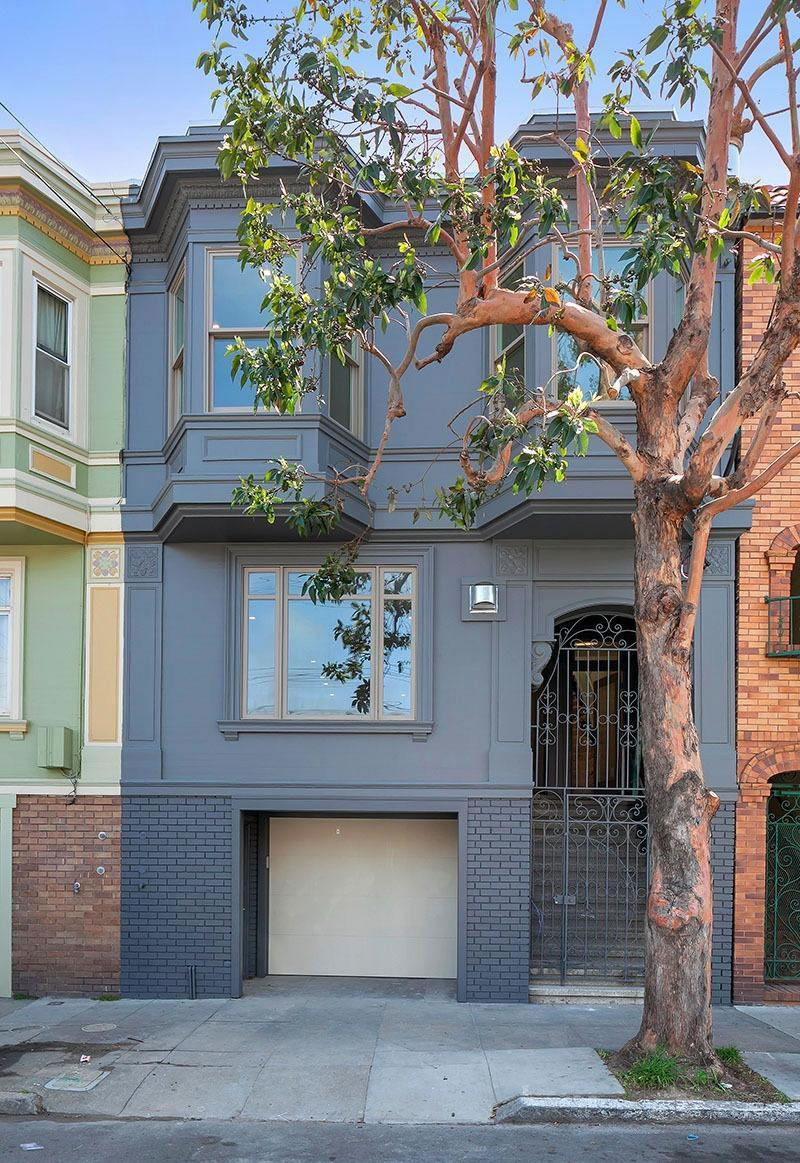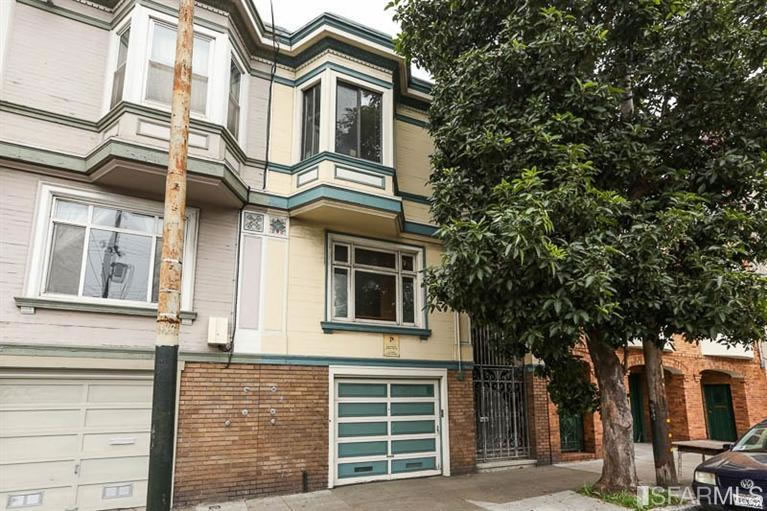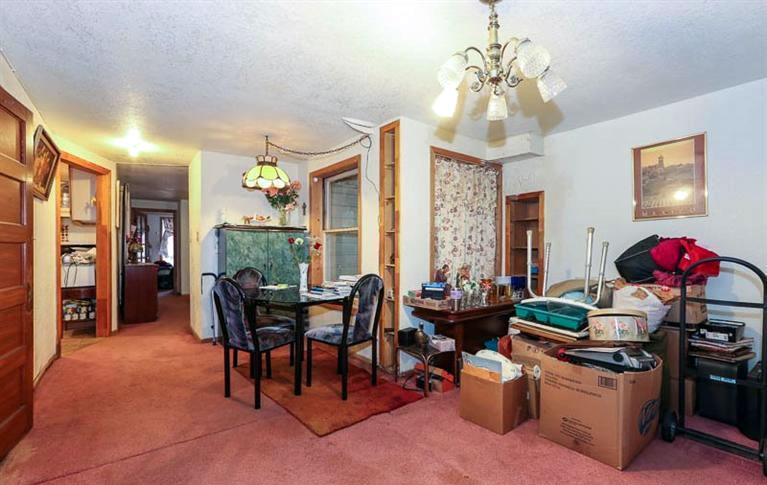The two-unit Mission District building with an unwarranted in-law at 867-869 South Van Ness Avenue was purchased for $1.625 million early last year, with the upper unit occupied by a protected tenant, an elderly couple estimated by a reader to be in their late 60s.
Five months later, the building returned to the market for $1.995 million, listed as “VACANT” and “a great opportunity for a developer or investor to rebuild or a savvy owner-user who wants to create their dream home.” But the property was subsequently withdrawn from the market without a reported sale.
Late last year, permits to remodel the building were issued and construction soon commenced.
This past May, 869 South Van Ness Avenue, the three-bedroom, top-floor unit was listed as a “studs out remodel” in a two-unit building (“eligible for fast-track [condo] conversion”) for $1.399 million.
And the sale of 869 South Van Ness Avenue has now closed escrow for $1.515 million ($1,075 per square foot), while the larger unit below, 867 South Van Ness, remains on the market listed for $1.799 million ($967 per square foot).
With respect to what happened to the tenants, there’s still no official word. But according to the City, there isn’t any record of an eviction, nor a required declaration of a buyout, on file for the building.







Possibly a “quiet” deal between the two parties involved.
Eviction? What eviction? Buyout agreement? What buyout agreement? They voluntarily moved out – got tired of the place. I liked them so much, I gave them a big check for their, uh, anniversary. Nothing to declare.
Maybe that’s why they could only afford one shade of battleship gray for the exterior.
Primer. So hot right now.
This is why SF desperately needs either a ballot measure – Prop P? – or a BOS resolution to require design review and approval for all exterior – or interior/visible from the outside – paint jobs.
🙂
OK, seriously, though, it sounds like we have an (all too rare) accord that this was a sad downgrade. (The photos don’t appear as a slide, so I’m holding out hope the top IS the “after”)
They did a nice job painting the bricks.
The top is clearly not the after, but the before — as evidenced by the crappy aluminum sliding windows in the upper bays, while the gray version has ‘correct’ wood double-hung windows.
And, just because this more modern monochrome look is popular now, as opposed to the multi-hued version of Victorians and Edwardians, does not mean either aesthetic approach should be dictated by the BOS – are you kidding? People can’t even pick the color(s) of their own house in your over-controlled backwards-looking world?
Two parties should be able to come to an agreement w/out the City being involved.
SF Gov needs to stick its nose everywhere. Ughhhh.
Yup.
To the best of my knowledge, there’s also no record of a permit being issued to remove the illegal in-law unit that was on the ground floor of this building, and that is now part of the “3 bedroom” lower flat (sans permitted “dwelling unit merger”).
If any of this slows down the condo conversion, a lawsuit is sure to ensue–but why would it? (Although, if Causa Justa and the Tenants’ Union had their act together, they would be monitoring all the small buildings that sell with tenants in place.)
Assuming there was a permit issued for the work which DID occur, I don’t think you’d need a separate permit to demolish the areas covered by that permit or permits. The fact that part of the building had previously been used illegally as a dwelling unit is kind of moot. It was no longer occupied, therefore it was not being used illegally as a dwelling unit and it essentially didn’t exist.(on paper) as a separate unit.
Incorporating that space (back?) into the remodeled unit was essentially correcting an illegal condition and making it go away.
Is it me or do all these listings look exactly the same? All-white cabinetry, slab island, bleached wood floor, limited moldings or interior details, blocky door handles (which I actually find uncomfortable to grab), etc.
While I understand interior design follows trends (read, granite countertops now are OUT), but is there really so little demand for anything that deviates from the modernist theme?
At least this is a relatively normal sized home. What I cannot stand is when a large mansion gets this stripped down treatment and when standing at one end you can see all the way to the other end three or four groupings of sofas and a couple dining table and chair groupings. Those make me think I am in a furniture show room.
A creepy flourish I recall from a couple years ago. The parent had wired the bedrooms with security cameras so there was no space for the children that was private. As soon as I outgrew the training wheels on my bike I would have been out of there.
Indeed. In a home like this it’s okay due to the abundance of them. When a large grand Victorian or a mansion gets gutted, it breaks the heart. I like your comparison to these open floor plans and furniture showrooms. Very much appropriate.
One thing I’ve noticed is that there are very few pics online of new-ish construction looking different from flip modern. Pick up any mid/high end lighting catalog, and you can spend hours on Houzz or Google images just trying to find a pic of a particular sconce or chandelier in the wild. Maybe people see the same look over and over, most not even realizing that things could be different.
I agree. I feel the same way too about the current spate of cookie-cutter modern SF architecture.
Granite countertops are out? I must have missed that one. What is in?
Granite is considered dated by the overwhelming majority of buyers in both SF and the Peninsula. Marble and caesarstone/quartz are the preferred counters for kitchens and baths, and the only granite that seems to be cutting it is granite that is designed to look like marble.
You’ll notice that you don’t see granite in any new buildings, homes, or high-end remodels on this site and others.
That whole Tuscan granite/dark wood cabinet is totally “out” at this point in these price points.
This one has somewhat better marble than most.
Yes, they all look alike. But so do all the Victorians. Nothing really changes over time. New styles come and everything is built to look the same. Nothing new here.
Well they certainly pruned the bejesus out of that tree, didn’t they.
Yes, the second crime committed here! The first is obviously the paint job.
“Elderly couple estimated…..in their late 60’s.” Elderly, really? Ouch.
South Van Ness. Is there an appeal to it’s location?
Double ouch. We have friends in their early 80s who are not elderly.
Why would they recess the garage door (making the garage shorter)?
And criminal to paint the entire façade, all the trim, in one color. Ugly.
Truly. The green/white/yellow paint job on the house just to the left puts this monotone battleship gray to shame. (Got the paint for free from the graffiti abatement department?)
The recessed area by the garage door will be used as a urinal 🙁
I live nearby and wish I could un-recess my garage door.
They recessed the garage to add a servant / illegal in-law entrance.
I assume they had to recess the garage door to provide an egress from the backyard, since there’s no breezeway.
Beautiful building. This is what the city could look like if we abolished rent control, and property owners could afford to upkeep their deferred maintenance.
Guys guys guys, if we just let property owners do condo-conversions, we would develop more of an ownership culture in the city and that would threaten the renter-focused political status quo. So let’s be sure to make it as difficult as possible for people to own homes. Pricing, regulations, you name it.
Given how selfishly horrid the ownership class in SF is, I don’t exactly see the problem with doing everything to keep them from spreading.
What a silly comment, and I think you understand how silly it is.
I own my own condo in SF (not a landlord, and never have been), and I find myself to be pretty generous, and much more so than many of my friends/colleagues who happen to rent and who seem to not have enough desire to do the amount of volunteering I do nor contribute an adequate amount of their income to local not-for-profits.
I suppose I could draw a false correlation between owners and renters and their charitable tendencies as you have, but I understand there is in fact zero correlation.
People who are generous are generous with their time, money, love, etc. People who are not, are not. It makes not a lick of difference whether they are renters or owners.
“Ownership culture”? Bizarre, abstract idea, sounds like the GOP from the ’90s, disconnected from the fundamental issues that drive housing, and politics 101. I’m talking about your reference to “renter-focus”, whether the policy is good or not (I’m generally opposed to rent control – but recognize that it cannot simply be revoked, as you imply, once it has begun) is a response to a market condition.
You have to address the market condition – lack of supply – in a significant way, not on the margins like streamlining condo conversions and gutting some tenant protections. Or are you saying, kill all tenant protections? Good golly. How about, “let’s all love one another?”
Or, go run for office on a “kill rent control now and eliminate all tenant protections” platform. Let’s see how big your coalition becomes. At least you can find a decent sized constituency for building, if not a majority.
“You have to address the market condition – lack of supply – in a significant way, not on the margins like streamlining condo conversions”
Define ‘significant.’ The author of all of the posts on this site has repeatedly pointed out how few housing units (SFH, condos, what have you) are for sale at any point in time. For instance, in early May the number of condos on the market was up 60%(!) YOY but the absolute number of condos on the market was only 447.
If we could condo convert an additional 1000 units per year into the ownership pool, it would make buying a home in San Francisco much more attainable. Relatively small absolute changes in inventory can have an impact, at least according to some market observers…
how would converting more rental units into condos increase the total supply of housing in SF?
SF has been converting PDR, industrial, and fwy properties into housing to increase supply. Those have all had a significant impact on supply.
Jake – You seem to have missed my distinction between the supply of properties available for individual ownership vs. the supply of housing generally.
Converting an apartment into a legal condo does nothing to change the absolute supply of housing, but it could do much to make home ownership a possibility for more people of more modest means.
Rules that specifically retard and make expensive the condo conversion process only reinforce the existing base of renter/landlord relationships. This makes it more difficult for the average family to own a home in San Francisco.
Should our legal process allow middle income families to stay in San Francisco? Let them buy homes in existing buildings that meet code and don’t require onerous planning/design debates. Let them build their own equity through ownership and not build the equity of a landlord.
Oh, I understood your distinction very well. I really don’t care about it. I think it is bad policy to provide massive subsidies for home ownership. I think property owners (including me) get far too much in gov’t subsidies and the gov’t does far too much in legislation and infrastructure investment to favor us. That’s mostly from Fed and State govs, but then they are the big players. Focusing on the relatively minor impact of local govs is disingenuous, IMO.
But sure, SF has some laws and regs and processes and bureaucrats and NIMBYs empowered by it all that has negative impacts as you mention so often. Mouse nuts compared to what you ignore so often, even when address directly to you.
In fact, “our legal process [does] allow middle income families to stay in San Francisco”. I know many of them personally. Really no doubt about it. Just because you don’t like that for some of them that depends on rent control doesn’t mean they aren’t living here in SF.
And people of “modest means” do buy houses every day. Some in beautiful Vallejo, IIRC.
We are making it difficult to own homes through “pricing”?
Yes, with our property appreciation rates over time having been so high, no one will buy or build to own here. That’s logic and why we should repeal the mortgage interest deduction and prop 13 to unfetter the ownership cult of these cruel welfare for the well-off burdens inflicted by the political status quo. Freedoms just another word for nothing left to write-off.
The blog author intimates that an unregulated buyout occurred at this property. A formal, regulated buyout would have subjected the property to substantial additional limitations on future condo conversion. How is the public good served by limiting condo conversion because of a voluntary agreement between landlord and tenant for the tenant to end his/her tenancy?
What impact do the restrictions (and specific fees) on condo conversion have on the price of housing in the San Francisco? Are there more units available to purchase in multi-unit buildings, or are there fewer?
I suspect that the only question the Supes care about is a little different: As a result of the restrictions/fees on condo conversions, are there more units available to rent in multi-unit buildings (and, more specifically, more rent-controlled units to rent)?
I totally agree. This was my original point. Supervisors are elected by a population of renters. Laws that preserve rentals preserve supervisor jobs accordingly.
Those laws and regulations also preserve a bifurcated market with high prices putting home ownership out of reach for all except the wealthiest. Market-rate landlords continue to extract excess profits and renters, even those protected by rent control, see the chance to own a home in San Francisco spiral ever further out of reach. Status quo.
Well stated. An anecdote about how the Supes take money out of their constituents’ pockets, and, ironically, place it into the pockets of the banks:
Close friends bought a 3BR TIC in a 3-unit building 5 years ago, all owner occupied. They finally were able to condo convert this year – 5-year, expensive process. Immediately after the conversion was done, they refinanced and knocked 2% off their loan rate — TIC loans can be had, but they are expensive (and this makes sense given the added risks to the lender). Saves them $8000/yr (for the next 30 years). So they paid their bank about $40,000 extra simply because they had to wait so long to condo convert given the labyrinth of rules. Thank you BOS (says the Bank of Marin, and the lawyers who were paid another $20,000).
And once again this is how the homeless problem is created. I’ve said it a thousand times.
Totally. 71% of the current homeless indicated they lived in SF.
I attended a San Francisco Business Times Real Estate Award event in 2013 where Mayor Ed Lee gave an opening speech. Among other things, he implored the real estate audience to ‘stop the speculation’. Three years later, I’d venture to say it fell on deaf ears.
Let’s revisit: These are real people, real families, and real lives.
So….a school teacher who has to commute from Brentwood is just out of luck. A heroin addict who has burned all bridges with family and friends gets a “free” apartment.
There are real people, real families, for sure. But being dysfunctional should not warrant special treatment.
SF school teachers have been forced out through Ellis Act evictions and rent increases, too. From an SFChron story on the same dated 12-30-2013: “…About 71 percent of the San Francisco Unified School District’s teachers live in San Francisco, and district spokeswoman Gentle Blythe agreed that affordable housing is a huge challenge for its employees.
A 2013 exit survey of 96 teachers leaving the district found that 45 percent said they were leaving to move out of the Bay Area, and 11 percent cited the cost of living or housing prices as a primary reason for relocating, she said. Eighteen percent said living closer to San Francisco would make them want to return to the district.”
Not quite sure why you immediately went to the herion-addict example?
Would you kindly inform us exact how many “SF school teachers have been forced out through Ellis Act evictions and rent increases”?
@ Conifer: Since 2010, I have personally known of 8 teachers who have chosen to leave San Francisco because of rent increases.
Of those, two were Ellis-Act (owner move in). Of the eight, three taught my child in pre-school. Five taught my child or my child’s classmates in Elementary school. I refer you to the Anti-eviction website as another resource, and, you can do your own homework if you are truly interested in learning about this. Just google “teachers being forced out of San Francisco because of rent increases” for a start.
Just curious, why can’t teachers commute? Everybody else does.
Ellis Act is one thing. Owner Move In is another thing.
“71% of the current homeless indicated they lived in SF.”
LOL. Of course they did. They know how this game is played.
I’d love to see a study that actually tries to verify where the SF homeless actually came from, rather than just taking their word for it.
Have you read the studies quoting the 71%? Do you have any expertise with homeless surveys?
I would recommend you read the full report report located here. Specific to this discussion is page 33. Another good resource is the anti-eviction project.
If you still have questions, open your mind and do your own research. There’s plenty of resources out there, if you truly want to investigate. Kudos to the City and other folks who have and continue to make an effort to research, quantify and extrapolate trends from hard data, rather than just blowing hot air into personal biases.
The anti eviction project is not a good resource. They’re perhaps the most biased, fact free group out there.
@WeOak – please see my posting to @what below. Meant this as a reply to you.
So are the people who will move in when the place is fixed up….
Is there evidence that recent events at 867-869 South Van Ness made anyone homeless?
Relying on the repetition of a phrase a thousand times as evidence of the truth of the statement is a good fallback for Donald Trump, but it doesn’t make that statement true.
Rent control suck! Our neighboring cities does not have issues with this, let the free market determine rent. Lot of landlords have rents that are very low compared to current market rent. When a rent control unit opens up, you bet they want to get maximum numbers.
Yes! Because apartments are so cheap in “neighboring cities” because they don’t have rent control. Neighboring cities don’t have NIMBYs, or high land costs, or high permit fees. Rent control is the only issue.
Believe it or not, sometimes people tire of SF’s “charm” and move away. I walked away from an awesome rent control apartment that was at least $1,000 below market rate.
And these folks undoubtedly walked away with a nice little nest egg.
Indeed, my friend helped one of his tenants buy a condo in the East Bay near Bart, and another a home with land in Oregon or Washington. Everybody is happy. Why does it have to be anybody else’s business?
SF rent control sucks because among other things, it is not needs tested. I would like to see rent control end by phasing it out unit by unit upon vacancy. So if you are in a rent control apartment, stay and benefit as long as you like. Once you move out though, the restriction is lifted. Its a pretty simple idea.
There are other more effective means of providing affordable housing to those in need, such as vouchers. I know many people and couples who earn well into the 6 figures (and maybe 7) living in a rent control apartment. Its not fair to the landlord, and its not fair to the less fortunate who need an affordable home in San Francisco.
Since when has political policy in SF been based on “fairness” rather than “power”?
Just now, somewhere a Supervisor’s aide read them your comment, and he laughed so hard he spit coffee all over his keyboard. Then he took his aide aside and said, “65% of voters are renters – never forget that. Now, go call the SF Tenants Union and tell them we’re working to expand rent control, and ask them how many volunteers we can expect to have knocking on doors during election time.”
I once told Aaron Peskin that Id like to see less rent control. I might as well have been talking to Zoltar.
Occasionally power and fairness align, like an eclipse, and you get something beautiful.
Publically subsidized housing was not intended to be a lifetime benefit, but meant to be transitional housing. The goal is to provide a hand UP not a hand OUT; To help the NEEDY not the GREEDY. Instead of building more low income housing at $500,000 a unit or renovating them at $250,000 a unit, the City should consider performing an income audit of older tenants or any tenant living large off of the government. Households that have grossly “graduated” out of the poverty level should be bought out to so subsidized units can be ROTATED to household truly in need. Although unsympathetic, it’s an efficient way to flood the affordable housing market. The additional benefit is no NIMBY to deal with.
A 2015 HUD report found a total of 20 “over-income” residents of SF public housing (out of 5000 units and 9700 residents — public housing accommodates a tiny percentage of SF residents). So the situation you describe is not widespread at all, but is very rare. And public housing residents’ incomes are already reexamined at least once every 12 months. Your wish is granted – long live Jambi.
What is the Statute of Limitations on Wrongful Eviction?
With vandals free to roam and deface property at will in SF, grey is the only reasonable color, since you will be doing touch ups over and over or be punished by the city as a victim of a crime they could care less about.
painting brick – that must be some kind of architectural faux pas.
Grey is a solid choice though. It used to be the default color, back in the days of coal & wood. Mediterranean pastel only became popular earlier last century.
Posted by Conifer 3 days ago: “Would you kindly inform us exact how many “SF school teachers have been forced out through Ellis Act evictions and rent increases”?”
Posted by NorCalGal 2 days ago: “@ Conifer: Since 2010, I have personally known of 8 teachers who have chosen to leave San Francisco because of rent increases.
Of those, two were Ellis-Act (owner move in). Of the eight, three taught my child in pre-school. Five taught my child or my child’s classmates in Elementary school. I refer you to the Anti-eviction website as another resource, and, you can do your own homework if you are truly interested in learning about this. Just google “teachers being forced out of San Francisco because of rent increases” for a start.”
YOU HAVE KNOWN 8 IN OVER SIX YEARS. That means that you have personally known 1.3 teachers per year in a huge school system. With all due respect to your sincere affection for these teachers, that does not constitute a crisis. It would be nice it they could stay, but no governmental answer is needed.
However, teachers are the most underpaid professionals, now that hospital nurses are very well paid. Arguing in favor of higher salaries would be much more justified than changing housing policy.
@Conifer: My limited direct and personal knowledge of eight teachers does not comprise the entire universe of affected individuals. If you live in San Francisco and are involved in real estate, surely you’ve heard of the recently passed law to protect teachers from no-fault evictions during the school year? This certainly was not in response to the plight of eight individuals.
The percent of people effected by Ellis act evictions in SF are a fraction of 1%. Much ado about nothing.
And that over reaching new law? Another reason landlords will be reluctant to rent to teachers. Don’t make them lepers!
The San Francisco Examiner posted an article on March 29, 2016 that indicates 2,134 evictions in 2014-2015. Their data, from the Rent Board, indicates that between 2009 and 2016, there were 12,022 evictions. Assuming 1/2 of all SF housing stock is rentals, and assuming a population of 850,000 – that is 28% of the population since the Great Recession. Hardly “a fraction of 1%”.
SF has ~215k occupied rental housing units, according to the US Census Bureau. Thus ~1% per year are evicted for all causes, according to the San Francisco Rent Board stats reported by sfexaminer in the article you referenced. The 12,022 evictions for all causes between 2009 and 2016 is less than 6% of the 215k total rental units. And that was over 7 years and for evictions of all kinds, not just Ellis evictions.
That article also mentions that “Evictions filed using the Ellis Act increased from 113 to 154 between the March 2014 to February 2015 and March 2015 to February 2016 period.” Notice that 154 Ellis evictions would be about 0.07 percent of all occupied rental units in SF. Even if this recently elevated level of Ellis evictions had obtained for the past 7 years, it would only be about one-half of one percent. Thus SFrentier was correct to characterize Ellis evictions in SF as “a fraction of 1%,” even when measured over your preferred timeframe.
FWIW, 60+% of SF housing is rentals. Used to be higher, but we are becoming an ownership seaside resort, despite the best efforts of the board of soviets.
I think your math is off there, even if we take all your assumptions. 1/2 of 850,000 is 425,000. 12,000 is only 2.8%, not 28%. Over 7 years, or less than 0,4% per year.
There was an op-ed in the Examiner the other day that said that a survey of 500 evictions in 2012 found that more than 65% of the people stayed in SF, some went to the east bay, and only a few moved out of the area entirely. Of course the columnist made it seem like a calamity that was sucking the lifeblood out of SF, even though we are talking about 120 people TOTAL who left the city. Not sure why he cites statistics that don’t support his argument.
Jake and katdip – thanks for the comments, insights and corrections. Yes, my percentage points were off – 2.8%, not 28%. However, 2.8% is more than the “fraction of 1%” mentioned by SFRentier. That said, please take a look at the graph – it’s clear that evictions increase when tech and other bubbles are present. Katdip – can you share the date of the Op-Ed Examiner piece you mentioned?
um, no. You seem to mix up Ellis evictions with all evictions, including evictions when people don’t pay the rent, and the most common is Breach of Lease Agreement. And you seem to mix up housing units (less than 400k in SF of which ~60% are rental) with population (~850k in SF). The evictions in the rent board stats are for eviction notices which tend to be one for a unit not one for each individual tenant in a unit.
Of course evictions go up in boom times: increased competition creates more population change. It is impossible to fuel the kind of tech booms we have without importing skilled labor. And we can never build new housing as fast as we can import the people via SFO and the freeways (sorry Amtrak, too slow). A modest community of VCs can pump billions into SF faster than any new housing can be constructed. Ya know most of the residents of SF weren’t born in SF.
Regardless, the Ellis evictions in SF alter a tiny percentage of rental housing, as SFrentier correctly stated and which you have at least twice misrepresented.
@Jake: Re: Misrepresentation of sfrentier’s comment re: Ellis Act %’s. First, while the overall percentage of people affected in the entirety of SF by Ellis-Act evictions may be a “…fraction of 1%”, those affected in specific neighborhoods such as the Mission, Castro/Eureka, North Beach and the Haight is clearly not “… a fraction of 1%”.. Without getting into the weeds and parsing percentages using a variety of different underlying metrics to support each personal and/or investment bias (which I’m certain each one of us can), my original post point was:
It’s fairly clear there has been abuse of the Ellis Act in SF over the years. That is why the BOS requested the SF Budget and Legislative Analyst prepare a Policy Analysis Report to analyze the level of tenant displacement occurring in San Francisco. The study was published October 30, 2013.
That is also why in 2014, SB1439 was passed, giving San Francisco the ability to curtail Ellis-Act evictions in the City.
Interestingly, after SB1439 passed, the number of Ellis-Act evictions went down and the number of OMI’s went up. As did the number of ‘breach of rental agreement’ just cause evictions.
Yes, I’m sure “there has been abuse of the Ellis Act in SF over the years.” I’m also sure there has been abuse of every kind of eviction in SF over the years. If everyone played nice and no one ever abused the landlord-tenant laws, then we surely wouldn’t need all the bureaucracy and the lawyers, and various partisans. Though we would need to check to see if Owsley had spiked the drinking water. More harmonious living through Bear chemistry.
The exaggerated political profile the Ellis Act has assumed in SF is truly much ado about very little. Perhaps not to the relatively few unfortunates Ellis evicted but statistically for the impact on rental housing and affordability. And especially so in comparison to the lack of attention given to many policies more directly under the control of SF gov with far more impact/potential, including the absurd structure, yuge cost, and marginal results of the BMR program.
FWIW, SB 1439 did not pass the Assembly, is not current law, and thus it would be difficult to argue that it motivated a change in owner behavior.
What actions constitute an abuse of the Ellis Act in your view?
@soccermom: Thank you for the correction. SB1439 passed the Senate, but died in Assembly. However, I respectfully disagree that the bill did not motivate a change in owner behavior. As you know, Investor/landlords keep a close eye on pending legislation, and how it might affect their bottom line profits. If I am an investor/landlord and know that there is a populist trend and potential legislation in the works that might curtail loopholes in existing laws that would prevent my ability to remove existing tenants who pay below market value, I may think twice about what strategy I pursue to evict them.
Re: What actions constitute an abuse of the Ellis Act in my view? In short, speculative investment behavior that breaks apart existing, cohesive residents of communities where long term relationships have created a strong bind. For those of us that live and work in San Francisco and have children who attend schools in the city, maintaining a cohesive community in a large, urban city is paramount. That community extends to include teachers and classmates families, local business owners and their employees, and neighbors.
FWIW I’ve worked in California real estate (residential and commercial / private and institutional / asset management and development) for 25+ years; I understand a number of different perspectives.
The study does not back up what you’re saying, and the law you cite was not passed. Earlier you used OMI and Ellis in the same sentence, parenthetically, as if they are synonymous. I think it’s clear that you truly do not understand what it is you’re attempting to talk about.
Au contraire, the study does back up what I am saying. Please crunch your own numbers. Additionally, see this recent article, with Rent Board stats, published by a Stanford grad student. There’s a link to to ‘explore the eviction data’ at the end of the article.
Further, Ellis-Act means the landlord is “going out of business” and retiring the unit from rental use. This can be for a number of different reasons, including deciding the move into it as an owner, but not formally evicting as an OMI. Legally, there are specific rules and regulations for an OMI vs. an Ellis-Act, but, if you are a landlord or real estate attorney in SF, I’m sure you are aware that most of the differences come down to restrictions and pay-out terms, plus what you can or cannot do with the unit following eviction under each.
yeah, like I said you don’t know what it is you’re talking about …
UPDATE: De-listed from the MLS without a reported sale last month, 867 South Van Ness has just been relisted anew for $100K less ($1.699 million) and now $913 per square foot.
If we have “protected” old tenants, we should have “protected” old landlords too…. In Portland PETA was harassing an old furrier and they got charged with Elder Abuse !
UPDATE: The sale of 867 South Van Ness has closed escrow with a contract price of $1.65 million ($887 per square foot).